There are some good gags and clever innovations in the animated Teenage Mutant Ninja Turtles: Mutant Mayhem, but there is one brilliant idea: casting Ice Cube as the voice of the movie’s mutant insect supervillain Super Fly.
It might have once been hard to foresee the value of having the emcee who rapped of “dropping bombs on your moms” as the MVP of a PG-rated kids movie. But we’re now up to the seventh Teenage Mutant Ninja Turtles film, not counting all the series and videogames. That’s a lot of movies for a bit of IP that’s clung more firmly to lunch boxes than it has to pop culture. For the turtles, it was getting to be time to either, as Ice Cube would say, “chickity-check yo’ self” or try something new.
Mutant Mayhem, currently in theaters throughout Taiwan, can’t entirely get over the feeling of trodding over well-covered turtle ground. But if we must go once more into the ooze, the film by director Jeff Rowe (co-director of The Mitchells vs the Machines) and co-written by co-producers Seth Rogen and Evan Goldberg, is probably the best of a not-so-stellar franchise. It’s certainly the one most invested with that “teenage” part of the turtles’ name. Plus, it’s got Ice Cube as a fly who quotes from the O’Jays.
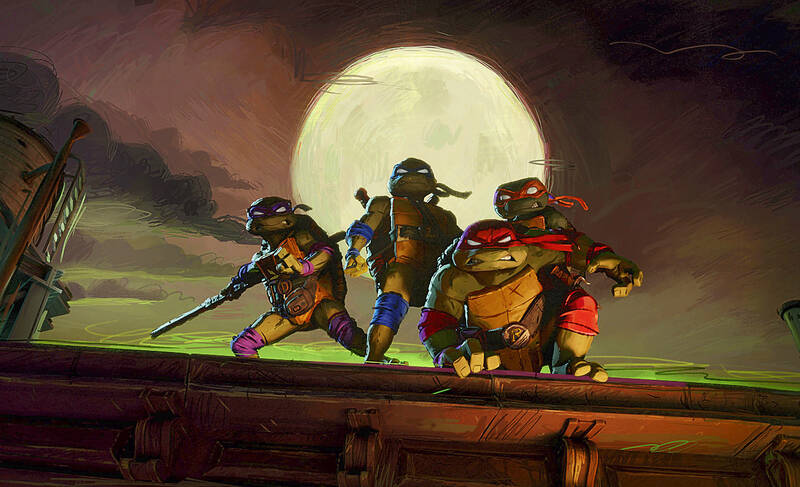
Photo: AP
The animation is vividly textured, the beat is persistently hip-hop (Lauryn Hill, De La Soul, Ol’ Dirty Bastard and others pack the electronic score by Trent Reznor and Atticus Ross) and the New York of the film is impressively detailed. But the most important twist to this Teenage Mutant Ninja Turtles iteration may be diving into the teenage-ness of its 15-year-old turtles.
If Barbie was balanced between Greta Gerwig’s childhood memories and her adult feminism, Mutant Mayhem gives itself over more fully to the mindset of adolescence. That’s in the gross-out humor and the comic book-like feel of the animation. But these are also recognizable teenagers who watch movies (Ferris Bueller’s Day Off), pine for concert tickets and make goofy phone videos of themselves slicing watermelons.
What Donatello (Micah Abbey), Michelangelo (Shamon Brown Jr), Leonardo (Nicolas Cantu) and Raphael (Brady Noon) really want is to fit in and go to high school like other teens. They have been relegated to the sewer ever since Splinter, a rat voiced by Jackie Chan, happened upon them after they were exposed as hatchlings to the same ooze that spawned Super Fly — who himself was the product of experiments by scientist Baxter Stockman (Giancarlo Esposito, fated to dubious laboratories).
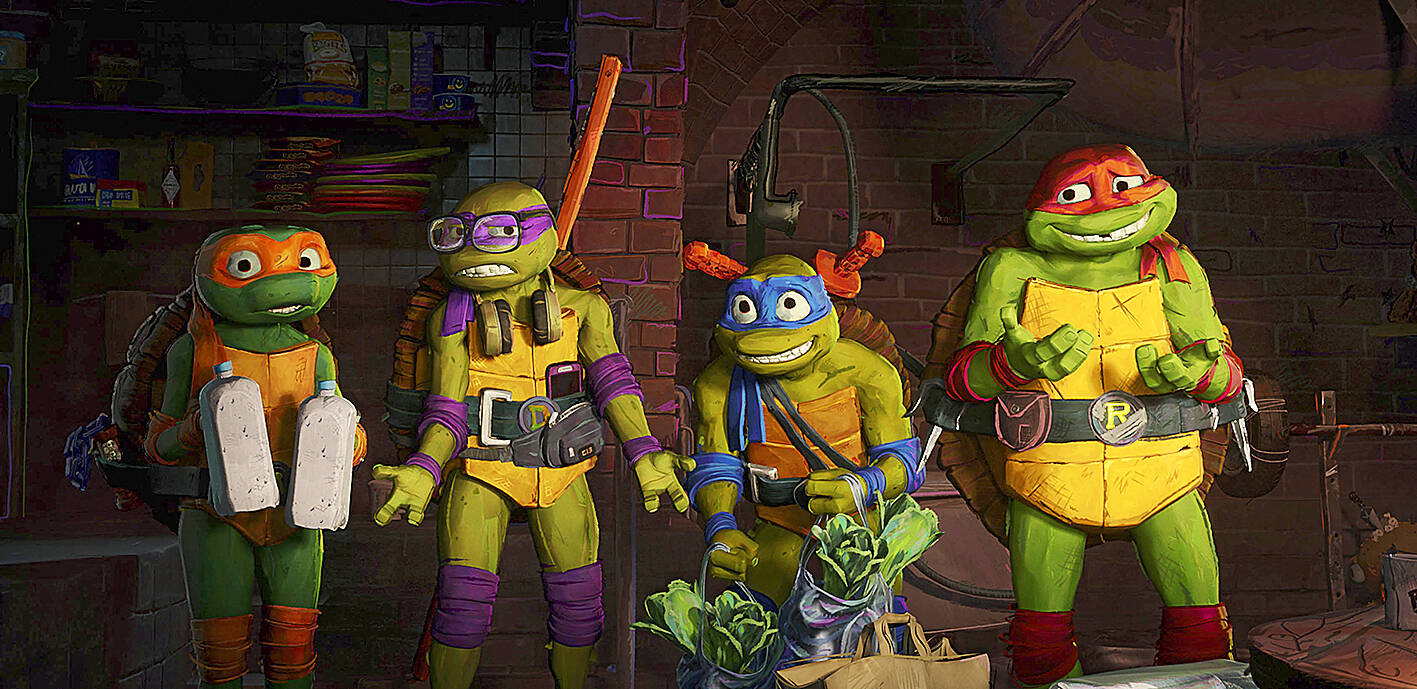
Photo: AP
Splinter has much the same opinion of the majority of the rats in Ratatouille: Humans can’t be trusted. (Splinter’s particular fear is that they will “milk” him.) So the turtles have grown up underground, a little like the homeschooled family of The Wolfpack, while yearning for the wider world.
They find a hint of it with a high-school journalist named April O’Neil (Ayo Edebiri), who wants to document, and thus prove to humankind, their decency. At the same, the turtles meet the charismatic Super Fly (voiced with bombastic aplomb by Ice Cube) and his band of mutants. At first, they’re fast-friends — “cousins,” Super Fly says — but the turtles then start hearing of Super Fly’s plans to turn all animals into mutants and eradicate the world of humans.
“Peoples, they got to go,” chimes one mutant.
Some of the thunder of Mutant Mayhem has been stolen by Into the Spider-Verse and this year’s Across the Spider-Verse — films that likewise upend the typical look of studio animation and do it with a pulsing soundtrack; but they did it more eclectically.
Yet this Teenage Mutant Ninja Turtles, while a half shell of those films, has its own low-key charms. It’s goofier, grosser and mostly fun. The four turtles are never more than a hard-to-differentiate bale of overlapping dialogue of doubt and anxiety. But that first word in their name finally feels genuine. Seven films in, it’s only right that Donatello, Michelangelo, Leonardo and Raphael should get a renaissance.
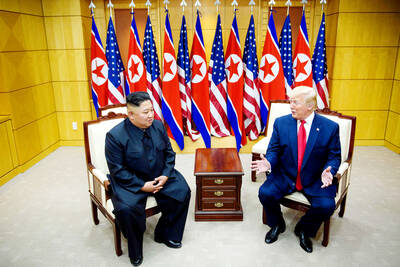
US President Donald Trump may have hoped for an impromptu talk with his old friend Kim Jong-un during a recent trip to Asia, but analysts say the increasingly emboldened North Korean despot had few good reasons to join the photo-op. Trump sent repeated overtures to Kim during his barnstorming tour of Asia, saying he was “100 percent” open to a meeting and even bucking decades of US policy by conceding that North Korea was “sort of a nuclear power.” But Pyongyang kept mum on the invitation, instead firing off missiles and sending its foreign minister to Russia and Belarus, with whom it
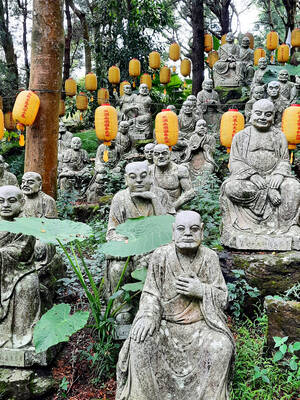
When Taiwan was battered by storms this summer, the only crumb of comfort I could take was knowing that some advice I’d drafted several weeks earlier had been correct. Regarding the Southern Cross-Island Highway (南橫公路), a spectacular high-elevation route connecting Taiwan’s southwest with the country’s southeast, I’d written: “The precarious existence of this road cannot be overstated; those hoping to drive or ride all the way across should have a backup plan.” As this article was going to press, the middle section of the highway, between Meishankou (梅山口) in Kaohsiung and Siangyang (向陽) in Taitung County, was still closed to outsiders
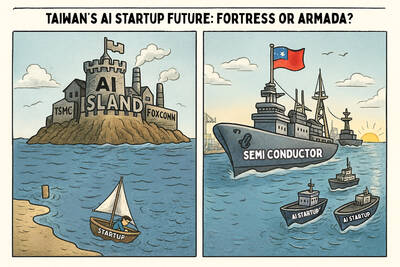
President William Lai (賴清德) has championed Taiwan as an “AI Island” — an artificial intelligence (AI) hub powering the global tech economy. But without major shifts in talent, funding and strategic direction, this vision risks becoming a static fortress: indispensable, yet immobile and vulnerable. It’s time to reframe Taiwan’s ambition. Time to move from a resource-rich AI island to an AI Armada. Why change metaphors? Because choosing the right metaphor shapes both understanding and strategy. The “AI Island” frames our national ambition as a static fortress that, while valuable, is still vulnerable and reactive. Shifting our metaphor to an “AI Armada”

Many people noticed the flood of pro-China propaganda across a number of venues in recent weeks that looks like a coordinated assault on US Taiwan policy. It does look like an effort intended to influence the US before the meeting between US President Donald Trump and Chinese dictator Xi Jinping (習近平) over the weekend. Jennifer Kavanagh’s piece in the New York Times in September appears to be the opening strike of the current campaign. She followed up last week in the Lowy Interpreter, blaming the US for causing the PRC to escalate in the Philippines and Taiwan, saying that as